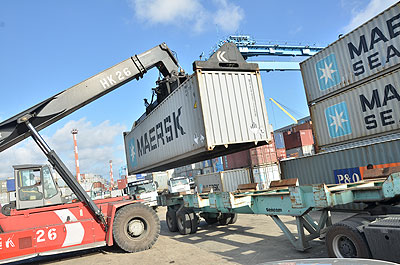Clearing goods at Mombasa port in Kenya has been made easy in recent days. Importers say it now takes one day for the cargo to be shipped from the port, following the establishment of the single customs territory in October last year.They add that the days the truck takes from the Mombasa Port in Kenya to Kigali have also significantly reduced to about five, down from 22 days before.


Clearing goods at Mombasa port in Kenya has been made easy in recent days. Importers say it now takes one day for the cargo to be shipped from the port, following the establishment of the single customs territory in October last year.They add that the days the truck takes from the Mombasa Port in Kenya to Kigali have also significantly reduced to about five, down from 22 days before."Rwandan and Ugandan clearing and forwarding companies have opened shop at the port and the clearing process is now very fast,” said Brian Biryomisho, a motorcycle importer.He, however, said there are still challenges at Gatuna border which gets overwhelmed by trucks, which he attributed to the increase in the number of players in cargo transport, following the ease of restrictions along the Northern Corridor.Biryomisho challenged the border officers to expedite cargo clearance to decongest the facility.Trucks must stop at the border to have their cargo checked through the weighbridges to avoid exceeding the 56 tonnes agreed upon by the member states.Mombasa port serves the hinterland of Kenya, Uganda, Rwanda, Burundi, South Sudan, the eastern Democratic Republic of Congo and Tanzania.The port operated by Kenya Ports Authority, has been criticised for the bureaucratic tendencies and delays that had been seen as an obstacle to trade in the region.The single customs territory, which has also seen a number of other non-tariff barriers lifted on this Corridor, was agreed upon under a trilateral framework which seeks to fast-track different intergration initiatives among Kenya, Uganda and Rwanda.Switching allegianceNgoga Ngarambe, the president of the association of pharmaceutical importers in Rwanda, said though they have been using the Central Corridor that connects Dar es Salaam Port in Tanzania to Kigali, they are planning to divert to Mombasa.He said his latest container spent three weeks at Dar port due to bureaucracy."We are going to divert to Mombasa port starting this year because it will save us time and money,” said Ngarambe.Jean Baptiste Gasangwa, a clearing and forwarding agent based in Mombasa who also doubles as Private Sector Federation representative at the port, recently said that revenue authorities from Rwanda and Uganda had already set up offices to commence the operations.Magerwa, the national bonded warehouse, has also established its offices at the port to help clear the goods destined for Rwanda, adding that traders had been incurring unnecessary costs in storage of their merchandise.Truck drivers speak outRogers Nyamutigiri, a Rwandan driver who ferries goods from Mombasa, said they now spend about four days on the way, adding that almost all barriers hadbeen eliminated. He cited the use of national identity cards to cross borders as one of the factors that have eased movement along the corridor. The IDs of Rwanda, Uganda and Kenya, came into use effective this year. Titus Hongo, a Kenyan driver working for Bollore Africa Logistics, said there were some challenges, citing some weighbridges that are still in place in some parts of Kenya.He said from Mombasa to the Malaba border between Kenya and Uganda, there are five weighbridges, urging that they should be reduced to allow imports and exports move faster."The roads are good, but problems like corruption, especially in Mombasa, are still prevalent,” he added.Hongo said some police officers pretend to be inspecting the vehicles yet they are actually seeking bribes from drivers.


